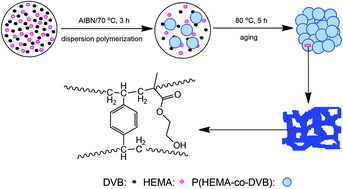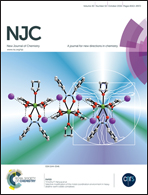Synthesis and characterization of functional porous organic polymers as efficient metallocene catalyst supports†
Abstract
Functional porous organic polymers (POPs) {poly(2-hydroxyethylmethylacrylate-co-divinylbenzene) [P(HEMA-co-DVB)]} with different pore structures and morphology were prepared via a dispersion polymerization strategy. The effect of different solvent types, different ethanol/H2O volume ratios in the mixture solvent, and the (HEMA)/DVB molar ratio on the specific surface area and porosity was investigated. Non-local density functional theory (NLDFT) simulation based on nitrogen sorption porosimetry and scanning electron microscopy (SEM) were used to study the pore structure and morphology of the prepared P(HEMA-co-DVB) particles. The results showed a trend that P(HEMA-co-DVB) particles with a higher specific surface area and a lower average pore diameter were obtained in ethanol/deionized water mixture solvents with better thermodynamic compatibility; however, when different types of solvents were used, a higher average pore diameter (14.5 nm) and total pore volume (0.923 cm3 g−1) were achieved in a good thermodynamically compatible solvent–ethyl acetate. The HEMA functional comonomer could also be a good pore-adjuster that provides a feasible route to prepare functionalized PDVB particles with controllable pore structure and particle morphology. In the ethylene homopolymerization evaluation of supported metallocene catalysts, these nanoporous polymer supports reveal better catalytic activity compared with silica used as the metallocene support, exhibiting great potential for future applications in the polyolefin catalysis industry.


 Please wait while we load your content...
Please wait while we load your content...